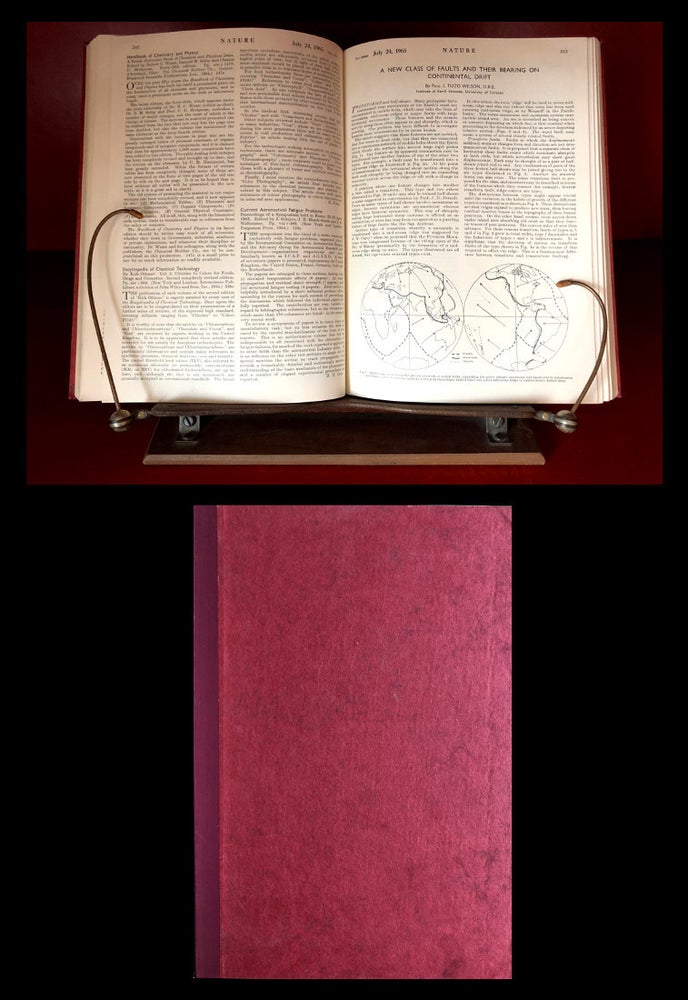A New Class of Faults and their Bearing on Continental Drift in Nature, Vol. 207, pp. 343-347, 1965
London: Macmillan, 1965. 1st Edition. FIRST EDITION (full volume) OF JOHN TUZO WILSON’S 1965 GROUNDBREAKING INTRODUCTION OF THE CONCEPT OF THE TRANSFORM FAULT, THE PAPER THAT FOUNDED PLATE TECTONICS” (Dewey, Marking 50 Years of the Wilson Cycle, Geoscience Canada, 43, 2016, 283). “Whereas previous theories of continental drift had conceived of plates as either moving closer together (convergent plates) or further apart (divergent), Wilson asserted that a third kind of movement existed whereby plates slide past each other. This theory became one of the bases for plate tectonics, which revolutionized the geophysical sciences” (Encyclopedia Britannica). [Note that we offer other important Wilson papers separately].
Though Wilson wrote other papers of interest in 1962 and 1963, prior to 1965, he was “a staunch anti-drifter”, meaning he didn’t believe in continental drift. In 1965, Wilson began to tie “together many threads to create a cohesive paradigm that embraced continental drift, sea-floor spreading, subduction, and very large motions on transcurrent faults that defined the boundaries of and sites of relative motion between plates, the basis of what would come to be known as plate tectonics” (Dewey). His earlier work, even though anti-drifter, combined with his 1965 papers, “culminat[ed] in his definitive 1965 paper [this paper] that founded plate tectonics” (ibid). Wilson’s 1966 paper, “Did the Atlantic Close and then Re-open” [which we offer separately], extended the possibility of continental drift before the break-up of the once supercontinent Pangea was likewise seminal.
“One might fairly say that Tuzo’s 1965 paper [this paper] changed the course of global tectonics and that his 1966 paper led to a complete new understanding of the implications of his 1965 paper for the origin of mountain belts resulting from super-continent cycles, the most important paradigm change in the history of geology” (ibid, 285). His contributions to the theory of plate tectonics “introduced to the mainstream the idea that continents and oceans are in continuous motion over our planet’s surface” and in so doing, revolutionized the ways we understand the Earth (Heron, Plate Tectonics, The Conversation, July 4, 2016). Scientific American counts Wilson’s discoveries as one of the century’s five major advances in science.
ALSO INCLUDED: Nobel Prize winner Joshua Lederberg’s “Signs of Life: Criterion-System of Exobiology”, pp. 9-13. In 1960s, Lederberg “introduced computer science and artificial intelligence to the biomedical laboratory” (NIH). He “started working with computers and quickly became tremendously interested in creating interactive computers to help him in his exobiology research. Specifically, he was interested in designing computing systems that to help him study alien organic compounds… [He] helped devise a system called Dendritic Algorithm (Dendral) that was able to generate possible chemical structures corresponding to the mass spectrometry data as an output" (Wikipedia).
ALSO INCLUDED: K. Popper’s “Time’s Arrow and Entropy”, pp. 233-234. Popper “attacks the significance of irreversible thermodynamic processes. He claims that with very few and short-lived exceptions, the entropy in almost all known regions (of sufficient size) of our universe either remains constant or decreases, although energy is dissipated (by escaping from the system in question)” (Esfield, Popper on Irreversibility and the Arrow of Time, 4). Item #1047
CONDITION & DETAILS: London: Macmillan and Co. 4to (263 x 200mm). Volume 207, complete (the front wraps for the July 3rd & Aug. 7th issues are bound in). Ex-libris, minimal markings (slight tonal difference at the spine from spine label removal. [li], 670, [6]. Tightly and solidly bound in clean, bright red cloth, gilt-lettered at the spine. Bright and very clean throughout. Very good +.
Price: $225.00

